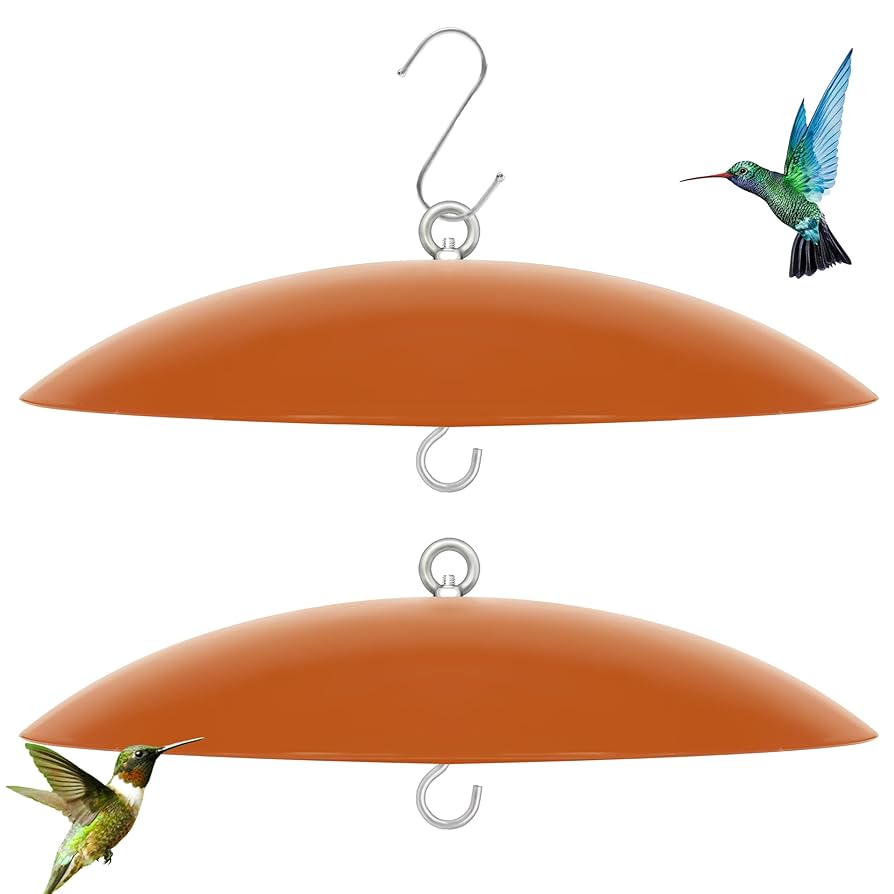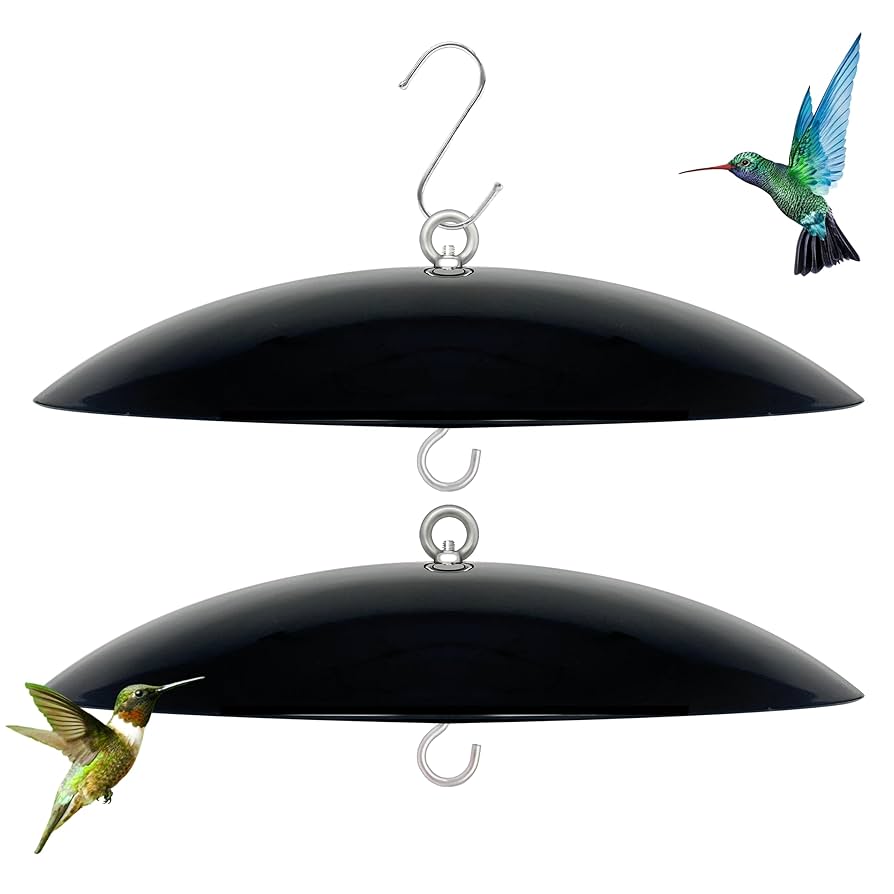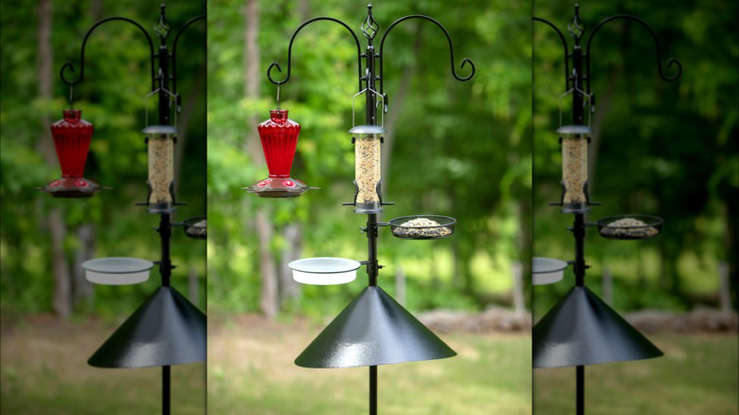Are raccoons turning your peaceful backyard into a chaotic mess? If your hummingbird feeders are their target, you’re not alone.
Raccoons are clever creatures that can quickly turn into unwelcome guests, especially when they decide your bird feeders are their new favorite snack spot. You might feel frustrated watching these nocturnal nuisances disrupt the serene environment you’ve worked hard to create.
But don’t worry—there are simple and effective strategies to keep them at bay. You’ll discover smart tips that not only protect your feeders but also ensure your backyard remains a haven for hummingbirds. Ready to reclaim your space? Let’s dive in and solve this problem together.

Credit: www.amazon.com
Why Raccoons Target Feeders
Raccoons often visit hummingbird feeders because these feeders offer an easy source of food. The sweet nectar inside attracts them strongly. Understanding why raccoons target feeders helps protect your hummingbirds and keep raccoons away.
Raccoon Feeding Habits
Raccoons are nocturnal animals. They search for food mostly at night. They have strong paws to open containers and reach food. Their diet is varied and includes fruits, insects, and sugary substances. This makes hummingbird feeders a perfect target for them.
Attraction To Sweet Nectar
Hummingbird feeders contain sugary nectar. This sugar provides a quick energy boost for raccoons. The sweet smell easily draws them from a distance. Nectar is easier to find than natural fruits or insects at night. This is why raccoons often visit feeders instead of other food sources.

Credit: www.amazon.com
Choosing Raccoon-proof Feeders
Choosing the right feeder can help keep raccoons away from your hummingbird nectar. Not all feeders are made to stop these clever animals. Some designs make it hard for raccoons to reach the food. Picking a feeder with the right features is key to protecting your hummingbird supply.
Design Features To Look For
- Feeders with built-in cages or guards block raccoons’ access.
- Weight-sensitive perches close the feeding ports when heavy animals land.
- Feeders with small feeding ports limit access to hummingbird beaks only.
- Hanging feeders with smooth poles prevent raccoons from climbing.
- Feeders designed for easy cleaning reduce spilled nectar that attracts raccoons.
Materials That Deter Raccoons
- Metal feeders resist chewing and clawing better than plastic ones.
- Stainless steel parts hold up well against raccoon damage.
- Glass nectar containers avoid scratches and cracks from animal claws.
- Use smooth, slippery materials for poles to stop climbing.
- Avoid wood feeders, as raccoons can chew through them easily.
Placement Strategies
Placement strategies play a crucial role in keeping raccoons away from your hummingbird feeders. Choosing the right spot can protect your feeders from unwanted visitors while still attracting beautiful hummingbirds. Let’s look at how you can position your feeders to enjoy the birds without the raccoons causing trouble.
Ideal Locations To Hang Feeders
Pick spots that are visible but challenging for raccoons to reach. Hanging feeders away from trees, fences, or structures gives raccoons fewer jumping points. You want a clear area around the feeder so raccoons can’t easily leap onto it.
Consider placing feeders near windows or where you spend time outdoors. This lets you watch the hummingbirds closely and scares off raccoons with your presence. You might find hanging feeders on a thin pole in the middle of your yard helpful, as long as it’s far from anything raccoons can climb.
Using Height And Distance
Height matters more than you might think. Raccoons are excellent climbers but struggle to reach feeders hung 6 to 8 feet above the ground. Make sure the feeder is at least 10 feet away from any nearby tree branches or structures.
Distance also helps. If you hang feeders close to a raccoon’s favorite hangout, you’re inviting trouble. Try placing feeders at least 15 feet from your porch, deck, or trash cans where raccoons often explore.
Have you noticed that raccoons avoid open spaces? Use this to your advantage by hanging feeders in open, well-lit areas. This simple change can reduce nighttime visits from these clever critters.
Physical Barriers
Physical barriers create a strong line of defense against raccoons near hummingbird feeders. These barriers block raccoons from reaching the feeder while keeping hummingbirds safe and undisturbed. Using physical barriers is a practical and reliable way to protect your feeders without harming the animals.
Baffles And Guards
Baffles and guards are devices designed to stop raccoons from climbing to feeders. They work by creating a slippery or unstable surface that raccoons cannot cross. Installing a baffle on the pole or hanging wire of your feeder can keep raccoons from getting close.
- Baffles are usually made of metal or plastic.
- They can be cone-shaped or cylindrical.
- Place baffles below the feeder or on the pole.
- Make sure the baffle is wide enough to block raccoon paws.
Guards work similarly but may cover the feeder’s base or hanger. Both options prevent raccoons from grabbing the feeder or climbing up to it.
Protective Cages
Protective cages surround the hummingbird feeder with a metal or plastic frame. These cages let small birds fly in but keep larger animals like raccoons out. The cage acts as a barrier that raccoons cannot squeeze through or knock down easily.
- Cages come in different sizes and shapes.
- Choose a cage with small openings to block raccoons.
- Ensure the cage does not block hummingbirds from feeding.
- Secure the cage tightly to prevent raccoon entry.
Protective cages offer excellent protection and add an extra layer of security. They help keep raccoons away without disturbing the natural feeding habits of hummingbirds.
Feeder Maintenance Tips
Keeping raccoons away from your hummingbird feeders requires more than just clever placement or special feeders. Maintaining your feeder regularly plays a huge role in deterring these clever critters. Simple habits like cleaning and removing spilled nectar can make your feeder less attractive to raccoons while keeping it safe and healthy for hummingbirds.
Regular Cleaning
Cleaning your feeder often prevents the buildup of sticky nectar and mold, which can attract raccoons and other unwanted visitors. Use warm soapy water and a soft brush to scrub all parts of the feeder at least once a week. Rinse thoroughly to remove any soap residue that might harm the hummingbirds.
I once skipped cleaning my feeder for two weeks, and the next day, I found raccoon footprints all around. That sticky residue was like a neon sign to them. Keeping your feeder spotless cuts down on scents that lure raccoons right to your backyard.
Removing Spilled Nectar
Spilled nectar on the feeder or underneath it is a tasty treat for raccoons. Check the area daily and wipe up any drips or puddles quickly. Using a tray or perch with a catch basin can help contain spills and make cleaning easier.
Have you noticed ants or bees swarming around your feeder? They often follow spilled nectar, which in turn attracts raccoons. Staying vigilant about spills creates a cleaner environment and reduces the chances of raccoons sniffing out your feeder.
Natural Deterrents
Natural deterrents offer a safe way to protect hummingbird feeders from raccoons. These methods use smells and plants that raccoons dislike. They keep your feeders safe without harming animals or the environment. You can try different natural options to see what works best in your garden.
Scent-based Repellents
Raccoons have a strong sense of smell. Certain scents can keep them away from your feeders. Try using natural smells like:
- Garlic or onion cloves placed near feeders
- Strong herbs like peppermint or eucalyptus leaves
- Sprays made from vinegar or citrus fruits
These scents make raccoons uncomfortable. Refresh them often to keep the smell strong. Avoid using harmful chemicals that can hurt birds or pets.
Planting Companion Vegetation
Some plants naturally repel raccoons. Planting these around your feeder creates a barrier. Choose plants with strong smells or rough textures. Good options include:
- Lavender
- Marigolds
- Rosemary
- Chili pepper plants
These plants discourage raccoons from coming close. They also add beauty and attract pollinators. Place them near feeders for best results.
Alternative Food Sources
Raccoons often visit hummingbird feeders searching for a sweet treat. Offering alternative food sources can help divert their attention. This strategy keeps feeders safe and hummingbirds happy. It also reduces damage caused by raccoons trying to reach the nectar.
By providing food raccoons like away from feeders, you create a distraction. This lowers the chance raccoons will bother your hummingbird setup. Setting up specific areas for raccoons satisfies their needs without risking your feeder.
Providing Raccoon-friendly Food Away From Feeders
Place fruits and nuts in a spot far from hummingbird feeders. Raccoons enjoy foods such as apples, grapes, and peanuts. Scatter these items on the ground or use a shallow dish. Make sure the area is quiet and safe for raccoons to eat. This alternative food source keeps raccoons busy elsewhere.
Keep the raccoon feeding area clean to avoid attracting other pests. Remove leftover food daily to prevent mold and smells. This helps maintain a healthy environment for wildlife around your yard.
Using Decoy Feeders
Set up a decoy feeder with sweet liquid or fruit juice. Place it away from your hummingbird feeder to lure raccoons. Use a strong, sturdy feeder that can handle raccoon visits. Check the decoy feeder regularly and refill it as needed.
Decoy feeders distract raccoons and reduce damage to hummingbird feeders. This simple trick can protect your hummingbird feeding area. It also gives raccoons a safe spot to satisfy their cravings without harm.
Behavioral Adjustments
Changing how you feed hummingbirds can help keep raccoons away. Raccoons are smart and adapt quickly to easy food sources. Adjusting your feeding habits can reduce raccoon visits and protect your feeders. These behavioral changes focus on timing and access control.
Feeding Schedule Changes
Feed hummingbirds during daylight hours only. Raccoons are mostly active at night. Take feeders inside or remove nectar before sunset. This stops raccoons from finding a midnight snack. Set a regular feeding time in the morning and early afternoon. Consistent timing trains hummingbirds to visit at set hours. It also keeps raccoons away from the feeder.
Reducing Nighttime Access
Remove feeders at night to avoid raccoon visits. Place feeders in areas raccoons cannot reach. Use hanging feeders with smooth, slippery poles. Raccoons struggle to climb these surfaces. Avoid placing feeders near trees or fences. These can act as bridges for raccoons. Use motion-activated lights or noise devices. These scare raccoons away from your yard. Nighttime access control lowers raccoon damage and feeder mess.

Credit: www.reddit.com
Frequently Asked Questions
How Can I Prevent Raccoons From Reaching Feeders?
Use baffles or hang feeders with sturdy, slippery wires. Place feeders away from trees or structures raccoons can climb. Secure lids tightly to avoid easy access. Clean spills promptly to reduce attraction.
What Type Of Feeder Deters Raccoons Best?
Choose feeders with raccoon-proof designs like weight-sensitive perches. Use metal or heavy-duty plastic feeders to resist damage. Feeders with protective cages also help keep raccoons away.
Does Changing Feeder Location Help Keep Raccoons Away?
Yes, relocating feeders to open spaces reduces raccoons’ access. Avoid hanging feeders near trees or fences. Frequent changes confuse raccoons and minimize visits to feeders.
Are Certain Hummingbird Nectar Types Less Attractive To Raccoons?
Raccoons are attracted to sugary nectar, so use fresh, clean nectar. Avoid over-sweetening as it attracts more wildlife. Regularly change nectar to prevent fermentation, which attracts raccoons.
Conclusion
Keeping raccoons away from hummingbird feeders takes patience and simple steps. Use sturdy, raccoon-proof feeders and hang them in open spots. Clean spills quickly to avoid attracting raccoons. Try natural deterrents like motion-activated lights or scents. Stay consistent with these methods for best results.
Enjoy watching hummingbirds without unwanted visitors. Protect your feeders and keep your garden peaceful. Small efforts make a big difference in keeping raccoons away.

